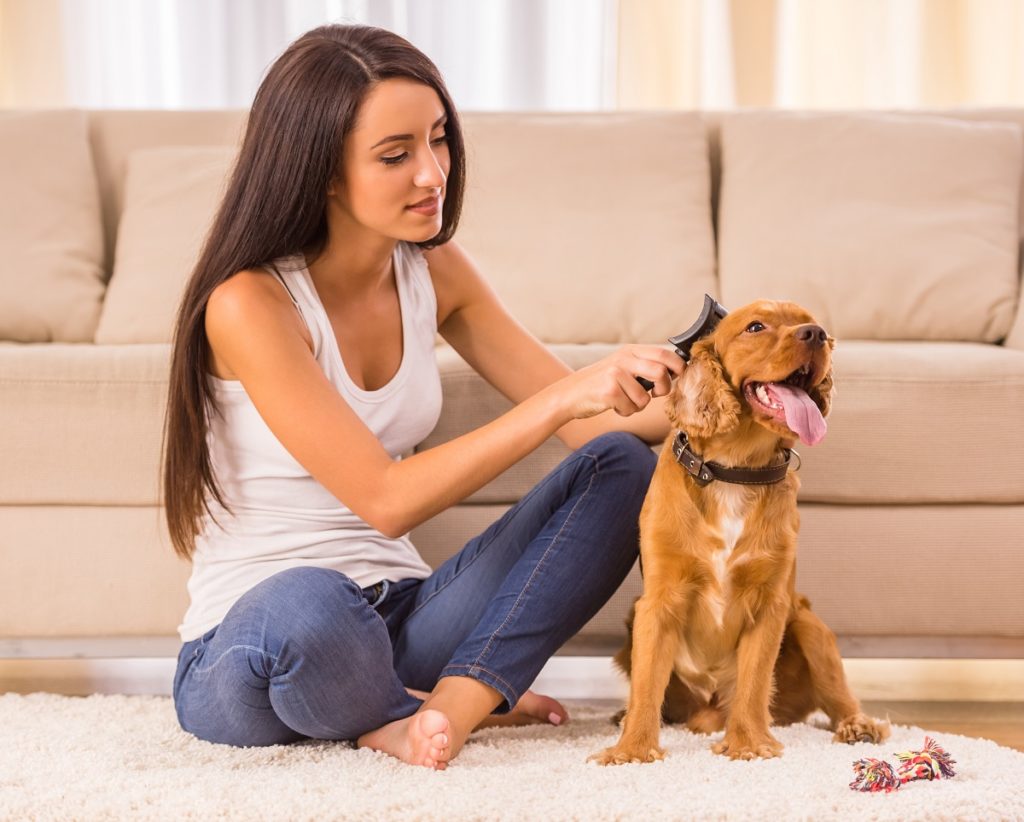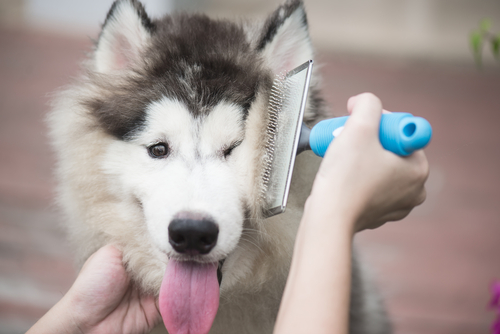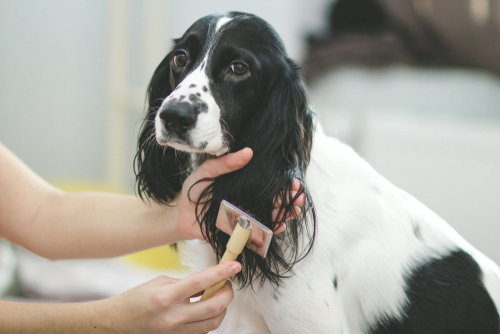Dog hair is everywhere—nestled in the cushions of your couch, piled in corners on the floor, clinging to the fabrics of your go-to black dress. If your pet is prone to shedding—or even worse, tangled mats in their fur—then you’ve probably considered a grooming regime to keep your pup’s coat clean-cut and healthy.
But what happens when you take out the brush and your pup goes running for the hills? Most likely, you’ll find yourself in a cat-and-mouse chase around the house to wrangle your nervous canine companion.
If you find yourself corralling your pooch during pamper time, here’s an in-depth guide on everything you need to know about how to brush a dog that hates being brushed, in addition to proper brushing techniques.
The Best Technique to Brush Your Dog
To make sure you’re providing your furry companion a comfortable experience, you must use a technique that keeps your dog calm and comfortable.
When working across the fur, never pull hard against mats or put too much pressure on the dog’s skin with the brush. Instead, imagine the way you might comb a kid’s hair and apply the same gentle touch to your dog.
For further assistance, here are some useful techniques on how you should apply the brush:1
- Go With the Flow – Avoid brushing against the natural flow of your dog’s hair. This may cause the brush to pull at their coat, which can cause discomfort. Brushing against the fur is only suitable for certain hair types, so make sure you’re always following the direction of fur growth unless advised otherwise.
- Treat The Fur with Care – Never try to pull too hard on snags—pulling too hard on your dog’s hair can cause damage and break the fur, and cause quite a bit of pain for your dog, too.
- Use Conditioner – If you find mats while brushing your dog’s hair, apply a mat-splitting solution like a conditioner or spray. Then use a mat-specific comb to work through the knot until their coat is silky and soft.
How to Brush Based on Your Dog’s Coat
No two dog coats are the same. The fur of each dog breed varies—from short and curly to long and wiry. When determining how to best brush your dog, first identify the type of coat your dog has:2
- Smooth (short) coat
- Curly or wooly coat
- Silky coat
- Double coat
- Wire coat
If you’re having trouble determining what kind of coat care your dog requires, reach out to your veterinarian for some pointers.
Techniques for Short, Smooth-coated Dogs
While dogs with short, smooth coats are often easier to bath and shampoo than the breeds with longer hair, you’ll find no shortage of shedding among this hair type. Dogs with short coats include breeds like:2
- Greyhounds
- Beagles
- Bulldogs
- Boston Terriers
- Pugs
For best results with this coat type, consider investing in a rubber brush or grooming mitt. The goal when grooming short hair dogs is to loosen shedding fur and dead skin. Loosen up the hair by grooming the dog in the opposite direction of the hair growth with the rubber brush, then follow with the grooming brush in the direction of growth to remove any loose hair or dirt.
Techniques for Curly or Wooly Fur
You might be familiar with the concept that some dog breeds have hair rather than fur—that’s the case with curly or wooly fur breeds. For these breeds, their single-layer coats are prone to minimal shedding, meaning their hair will continue to grow—and tangle if unchecked.3
Breeds with this coat type include:
- Malteses
- Poodles
- Labradoodles
- Cockapoos
- Bichon Frises
With these breeds and hair types, you’ll need to make sure you consistently brush your dog’s fur once every week. Curly coats are also prone to tangles closer to the skin, so it’s important to use a detangling comb to brush the hair from the root out. Once you’ve tackled the tangles, you can use a pin brush to style and fluff their hair.
Techniques for Silky Coats
Like the curly, wooly fur types, many silky coat dogs have long fur that grows more than it sheds. As such, their long hair makes it easy to tangle, so it’s important to keep a consistent grooming routine to avoid uncomfortable mats for certain breeds, including:
- Yorkshire Terriers
- Afghan Hounds
- Shih Tzus
- Lhasa Apso
To help tackle the long, silky locks, your best bet is a slicker brush—a wire brush with short bristles that help remove debris from the inner layers of the fur. Whereas for shorter silky coats, you should use a brush with bristles to help spread your dog’s natural oils to keep the coat healthy.2
For these breeds especially, you should consider brushing your dog’s hair weekly, anytime they get wet, and before and after their bath.3
Techniques for Double Coats
Notice any large piles of fur balls around your house? This is a sign that you’ve got a dog with a double coat. Double coats are made up of two different kinds of hairs: the longer outer fur and shorter fluffy interior fur. These layers are designed to help protect your dog from UV rays and cold in the winter, so you should never shave the following breeds:2
- Labradors
- Golden Retrievers
- Corgis
- Siberian Huskies
- Australian Shepherds
To help tackle the piles of fur during shedding season, you can invest in specific de-shedding brushes that help loosen both the under and outer layers of your dog’s coat. Groomers will often use high-velocity blow dryers for these breeds to loosen and blow away the shedding fur.3
Techniques for Wiry Coats
Dogs with wiry coats have two layers of fur: a soft underlayer and a thicker guard layer with wiry hairs. Because of this, the coat can be difficult to brush and groom. You’ll notice these coats on a lot of terrier breeds like:
- Jack Russells
- Scottish Terriers
- Dachshunds
For best results—and to manage the outer wiry hairs—use a slicker brush and follow the growth of your dog’s hairs. This is one type of coat you don’t want to brush against the growth as it can damage the texture and protective layer of the outer coat.
How to Brush a Dog that Hates Being Brushed
Some pooches don’t like to be pampered. These types of dogs often react to brushing time—or the brushes themselves—with anxiety, frustration, or fear. To curb these bad habits, approach grooming time with patience and lots and lots of love.
Why Does My Dog Hate Being Brushed?
Every dog has their own personality and preferences, and many of them have great memories. If your dog hates brushing, they might be conjuring back a time when something was scary or painful to them while being brushed as a puppy.
Other dogs simply don’t like new experiences or strange, foreign objects. To them, a brush is something new that makes them anxious or stressed about getting hurt. If you suspect your dog is anxious about grooming time, it’s important to build trust through positive reinforcement.4
How Do I Brush My Dog that Hates Brushing?
Whether your dog is too afraid to get groomed, or they’re too wiggly to brush, this step by step process is sure to make them comfortable and excited for brushing time:4
- 1. Create a Relaxing Space – Place your pup on a blanket, towel, or something cozy. Ideally, this space should be comfortable and confined so they won’t be able to run away from the brush.
- 2. Start with Treats – Have your dog sniff and examine their brush, then give them treats if they show a positive reaction. Most dogs are food motivated, but if this doesn’t work, try a grooming glove that makes them think you’re petting them rather than brushing them.
- 3. Brush in Small Sections – Begin brushing the areas your dog minds the least, whether that’s their belly, back, or ears. By focusing on small sections at a time, you can reward their calm behavior with yummy treats and goodies.
- 4. Break up the Brushing Time – Some dogs grow nervous or bored with extended grooming routines. Try splitting the brushing time up into chunks, rewarding your pet after each session with love and food.
- 5. Offer Compliments and Treats – To make each new attempt a positive experience, it’s crucial to offer your pooch compliments and treats when you brush zones that might be sensitive for them. Also, consider giving your pup a few CBD treats to keep them calm during their pamper session. CBD hemp oil may interact with your dog’s endocannabinoid system to promote full-body wellness and relaxation.
Make Brushing Time Easy with Canna-Pet CBD
Some pooches simply cannot sit still during brushing, and with all their jitters, it can be difficult to instill a positive brushing regime. Canna-Pet provides the best CBD for Pets to help your dog relax when it’s time to get groomed.
Canna-Pet CBD is safe, natural, and veterinary-approved. Our complete CBD products are the first and only whole-plant organic hemp extracts designed for pets. Try out our CBD treats during grooming time to ease your dog’s nervousness and keep them calm and relaxed—even if there are a few snags along the way.
Also, look out for our guides on healthy cat birthday treats to spoil your furry friend on their special day and how to treat anxiety in horses to relax your riding pal.
Sources:
- Dogtime. Dogs 101: Everything You Should Know About Brushing Your Dog. https://dogtime.com/dog-health/general/132-brushing
- Groomers. The Ultimate Dog Grooming Guide: How To Groom 6 Different Types Of Dog Coat. https://www.groomers-online.com/blog/2019/04/the-ultimate-dog-grooming-guide-how-to-groom-6-different-types-of-dog-coat/
- Preventative Vet. Caring for Your Dog’s Coat: Brushing, Combing, and Mats. https://www.preventivevet.com/dogs/how-to-care-for-your-dogs-coat
- American Kennel Club. Why Does My Dog Not Like Being Brushed? https://www.akc.org/expert-advice/health/why-does-my-dog-not-like-being-brushed/






